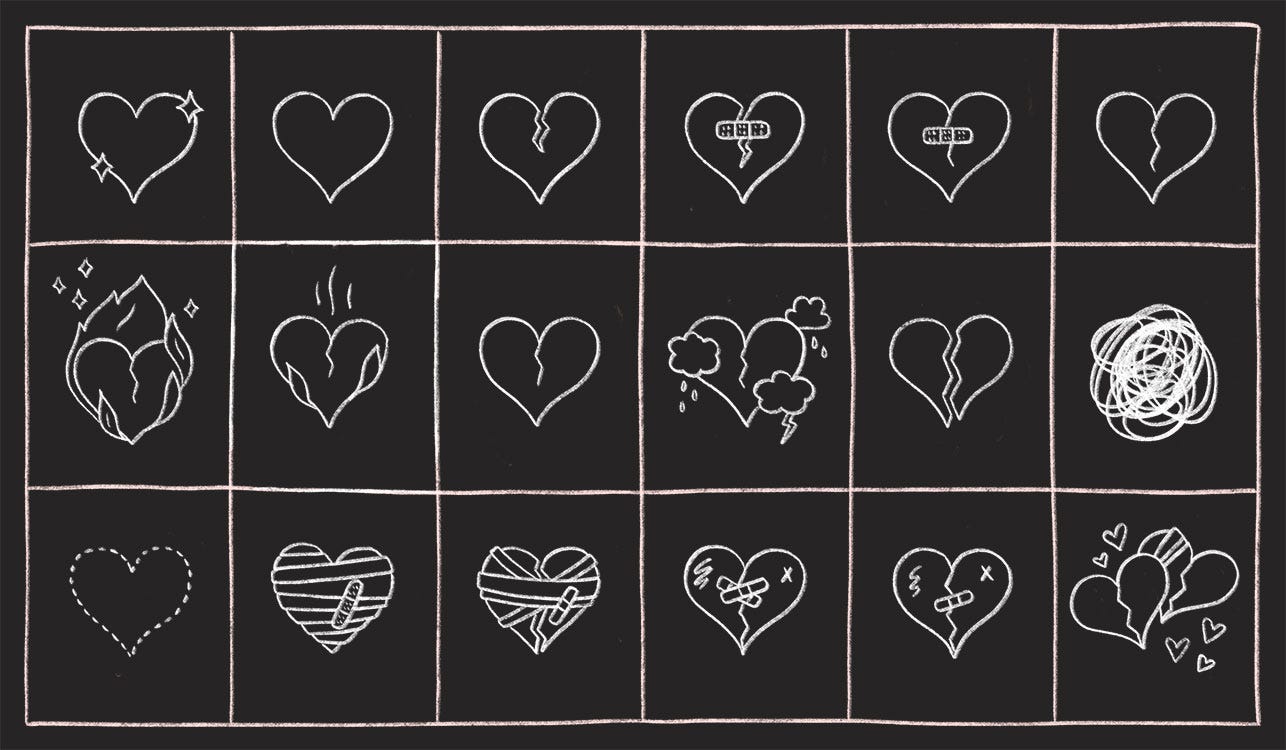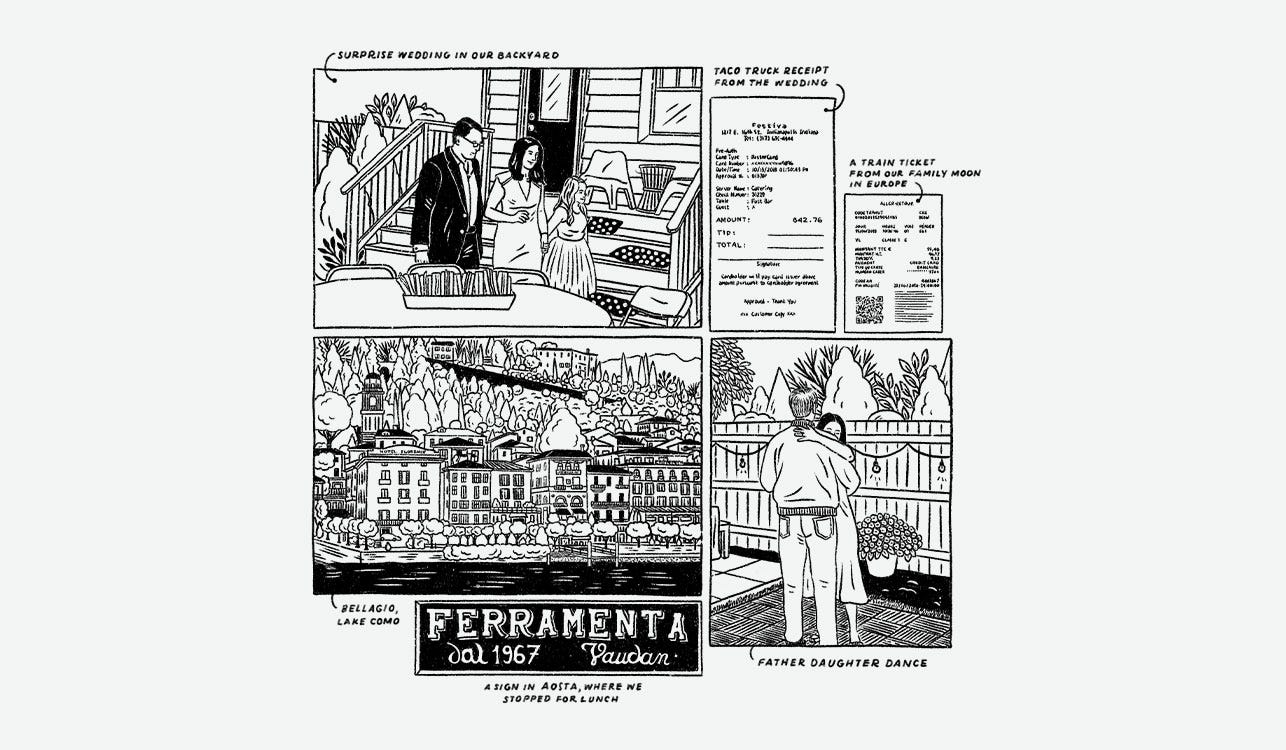After only two short little years, I finally found the heart of the story in A Brief History of My Affairs, so I’m rewarding myself by writing a newsletter.1 (For context, it took me ten years to understand what And Now I Spill the Family Secrets was about.) Initially, my new book was about heartbreak but now it’s an investigation of how my childhood relationships shaped the rest of my life.2 I made this progress through—drumroll—research. I thought I’d share what this process looked like and how I blend research with prose in a way that doesn’t put readers to sleep.3
For me, research begins with lots of questions and feelings (and maybe one or two crying sessions on the floor of my office) and ends with an ice-cold examination of why things shook out the way they did.
Let’s begin with the feelings. A Brief History of My Affairs originated in therapy when I suddenly realized that I had a secret.4 By then I knew that secret was just another word for shame, and I wanted to dispel that shame. I started to take notes after each session. I’d soon filled an entire notebook with scenes and questions. What happened? What led up to these moments? Who had been hurt? Why did I still care after so long?
After the initial burst, I wanted to see if my memories aligned with whatever evidence I’d kept. Was everything that happened a big deal, or not? Was I making a mountain out of a mole hill? Was I being a narcissistic drama queen? Over several weeks and months, I read through old letters, emails, text messages, chats, and phone records. I sifted through Twitter and Instagram feeds, and my now-deleted Facebook account. I listened to the songs that I’d played on repeat for so long.5 The ephemera made it clear: my life had been changed by two relationships. Like, set-fire-to-the-bridge-behind-you level of transformed. Everything that happened after (and will happen from now on) is impacted by those experiences. It was a big deal.
At this point, my feelings were still, shall we say, big, and I looked for stories of people who had struggled with relationships. I read Lori Gottlieb’s Maybe You Should Talk to Someone, Christie Tate’s Group, Stephanie Danler’s Stray, and parts of Esther Perel’s State of Affairs. I also listened to Perel’s podcast Where Should We Begin, and Dani Shapiro’s Family Secrets. I reread Dani’s Slow Motion and Cheryl Strayed’s Wild. All of these stories helped me understand how entire lives are shaped by love, how people move mountains to find happiness, and that stories are the means by which we share our experiences of it.
I tried to keep my new project to myself while I sorted through the mess, but if it isn’t abundantly clear by now, let me be explicit: I keep zero secrets. This was around the time I handed in my first book, and my literary agent called to sort of congratulate me but really to ask what was next. Luckily, I’d prepared for this by confessing the project to Christian and asking his advice. “You need one sentence,” he said. “You’re working on a book about inappropriate romantic entanglements.”6 When I said this, my agent lit up and we set out to write a book proposal.
Yada yada yada, Pantheon acquired the book.7
My first task was to create an outline (i.e. a timeline), which required precision. I searched through public records to find exact dates, examined old art projects made during the time in question, news articles, photos, videos, and interviews.
Research is not a straight line, and I quickly realized that the timeline I’d used in my book proposal no longer made sense. I needed to start further back, so I dove deeper into my archives to again look through emails, texts, chats, and photos from the aughts. (Plus I got to bask in the memory of wearing very old t-shirts and rolled-up, too-long jeans with off-brand tennis shoes and no makeup…those were the DAYS.)
My emotional distance from this further-back time period allowed me to scrutinize the past with a cold eye, leading me eventually to research the psychology underneath our relationships.
Let me be specific. Here is the email exchange I found (paraphrased) that was a turning point in my understanding of the book:
Boyfriend: “We can discuss marriage when you get back.”
Me: “If you want to discuss marriage, find someone else.”
Yikes! I hadn’t remembered this at all. (Sorry, him!) Why had I been so callous? Why was I pulling away? Why had he pulled away before that? What was this dynamic between us and what was the cause of it? Was it simply youth or something deeper? I searched online for terms that could describe our relationship. This led me to attachment theory, which gave me a framework for the entire book (and my life?) and is the heart of the story. I’m now examining everything that happened through this lens as I try to understand how one’s family history can lay the groundwork for her romantic life.
Now. As you already know, I am a firm believer in scenes as the building blocks of a book, but I also want to incorporate what I've learned along the way, which means passages of reflection. For me, a memoir is an investigation, and showing evidence is a way of building momentum in the story and, hopefully, earning the trust of readers. The first way I share evidence is by drawing it.8 Letters, photos, texts, books, playlists...I try to incorporate what I've found so readers can sort through the documentation alongside me. (Plus, it looks like a crime scene. Fun.)
Next, I try to blend ideas I've learned, like internal family systems and attachment theory, into the prose. After I’ve internalized my findings, I reflect on the past, knowing what I now know. The trick is to find moments in the text where passages of reflection, thinking, and analysis makes sense without pulling readers out of the scene for too long. How do you toggle between past and present naturally? My unsolicited advice for doing this is: revision, revision, revision. In other words, trial and error. This is where I’m at with A Brief History of My Affairs: revising the first section and taking a deep exhale, now that I [think I] know what the book is about.
Erm, I promise to make my next letter shorter. XO.
Because getting completely smashed in the middle of the week is not really an option for me anymore. I mean it is, but SOME people I live with would not be thrilled.
In other words, I’m learning about attachment. So now I flit around the house saying things to my husband like “Oh, that’s just your attachment issues flaring up. You should examine that” when we all know that it’s MY attachment issues dismissing his real true feelings, and also that this newsletter is just a front to talk about my marriage in the footnotes. THESE are the unintended consequences writing a memoir, people.
Ideally.
Several secrets, actually. (See also, the title.)
This may or may not have been one of the times I ended up on the floor of my office, but I was pregnant too, so…maybe it was the hormones???
Is this when he also suggested I set all keepsakes of my ex-boyfriends ablaze? I can’t remember! But don’t worry, my love. I have plans for a very large and cathartic bonfire.
This had more to do with agent magic than with me, but I can write a newsletter about the process if anyone in the world is interested.
One (sort of mean?) reviewer of my first book did point out the “scrapbooking” quality of my work, which I guess is true if mental illness and divorce are good material for a scrapbook? Anyway, at this point in life, if I could do nothing but make scrapbooks all day for my kiddos, that sounds like a DREAM. Think of all the memories I could store for them forever! Would their love for me increase with each album? Maybe!







I totally missed this post amid my book travel but so glad to catch up now! Love the graphic of the research process!
Hi, Margaret,
Your process analysis--articulate, analytic, and tantalizing-- should be required reading for creative nonfiction classes, grads and undergrads. Carry on!